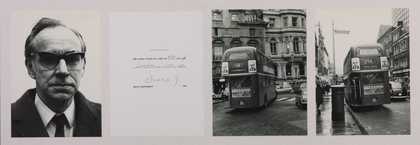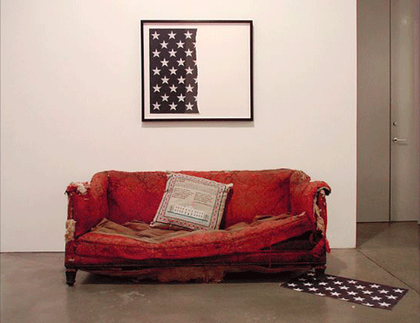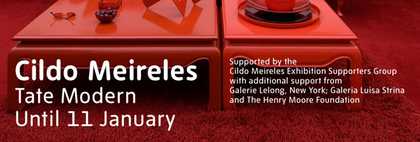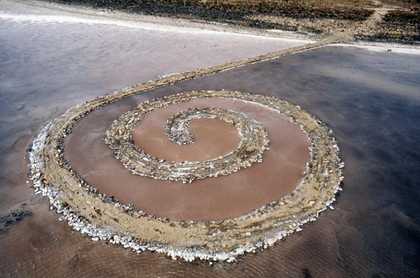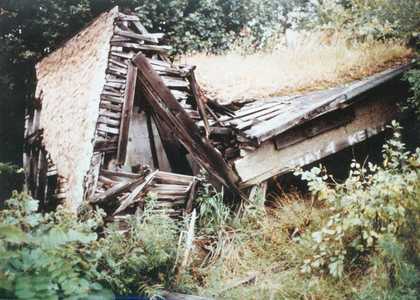Had Hans Haacke’s proposed Guggenheim show of 1971 gone ahead, gallery visitors would have been confronted with the following:
A white cube. A black bird with bright yellow stripes around the eyes sits in a chrome cage. It rocks gently on its perch. Silence. Occasional scrabbling sounds as the bird readjusts its footing. Time passes. Nothing happens. Suddenly, the caged bird speaks. ‘All systems go’ it squawks. And again, ‘All systems go.’ A pause. ‘All systems go. All systems go.’ Repetition to inanition. ‘All systems go.’
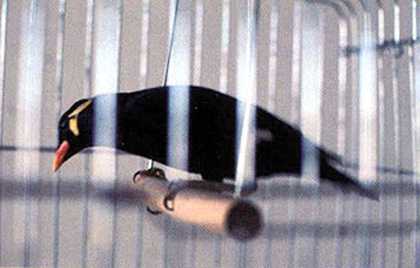
Fig.1
Hans Haacke
Norbert: ‘All Systems Go’ 1970–1
Unfinished project
Photograph of the mynah bird Hans Haacke attempted to teach to say: ‘All systems go’
© DACS 2006
However, the piece my fictional narrative purports to describe, Norbert: All Systems Go, 1971 (fig.1), remained unrealised. Haacke had tried to teach a mynah bird the phrase, ‘All systems go,’ which the bird, installed in a cage in the gallery space, was to have repeated at its own volition. The bird’s reluctance to parrot the phrase and the now infamous cancellation of Haacke’s show, put paid to the piece. Nevertheless, even treated as a conceptual proposal, it can be compared instructively with an earlier avian installation that Haacke did realise, Chicken’s Hatching, 1969 (fig.2). Here, freshly laid chicken eggs were collected from a brooder, transferred to an adjacent hatchery and distributed among a grid of eight small incubators. The hatching process was controlled artificially, via a simple feedback system of lamps and thermostat.
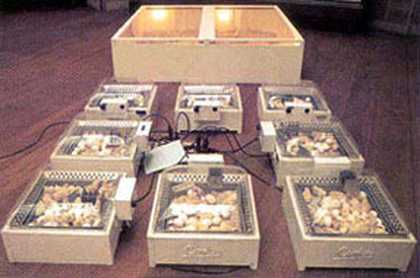
Fig.2
Hans Haacke
Chickens Hatching 1969
Fertilised eggs, incubators, lamps, thermostat
Dimensions variable
Photograph of installation in New Alchemy: Elements, Systems and Forces, Art Gallery of Ontario, Toronto
1969
© DACS 2006
Excepting their awkward logistics, both works might well have been included in the Tate Modern’s Open Systems: Rethinking Art c.1970 exhibition, held in 2005.1 Both pieces were conceived c.1970; both do advanced critical work on received notions of artistic agency, the object status of art, the role of the spectator and the medium of the artwork’s execution; and both works deploy systems theory as a conceptual resource for vanguard art practice. However, while Chickens Hatching makes direct use of the possibilities presented by cybernetic systems, Norbert: All Systems Go seems to negate them. In the later work the technology is stripped away and cybernetic theory, as developed by celebrated mathematician Norbert Wiener, is mocked, its optimistic feedback-steered vision of human progress undermined. The affirmative ‘All Systems Go!’ of Chicken’s Hatching becomes the sardonic refrain of a trained mynah bird in Norbert. How then should we account for the ideological gulf separating these two works? What broader implications might this brief narrative have for rethinking art c.1970?
It would be simple enough to rehearse a familiar argument here, explaining away this situation as a Neo-Avant-Garde repetition of the historical Avant-Garde’s failure to reconcile art and advanced technology, or, more precisely, the failure to respond affirmatively to the perpetual question of whether the labour of industrial production and the labour of cultural production can and should be related.2 However, this would amount to little more than a stock response – it offers insufficient purchase on the complex issues at play.3 Surely a relation between the labour of industrial production and the labour of cultural production might be conceived that is not strictly isomorphic? Surely modes of theory and practice could be imagined which do not immediately collapse culture into industry?4
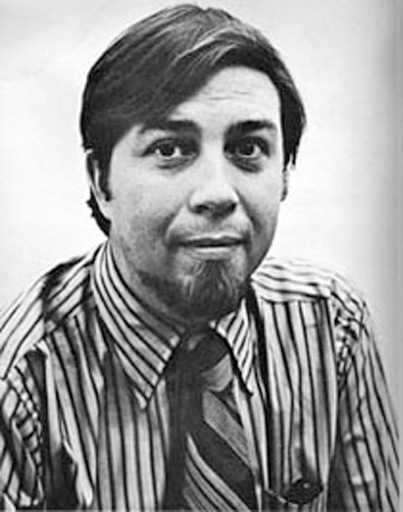
Fig.3
Unknown photographer
Photograph of Jack Burnham (exhibition curator)
Reproduced in Software. Information Technology: Its New Meaning for Art, exhibition catalogue, The Jewish Museum, New York, 1970, p.10.
Systems theory, as it came to be understood and applied in art practice in the late 1960s and early 1970s, seemed to offer exactly such possibilities. Haacke had been introduced to systems thinking by Jack Burnham, a prominent critic, occasional curator and close personal friend. In fact, Haacke justifiably credits Burnham with introducing systems theory to the 1960s art world at large, through his writing on ‘systems aesthetics’.5 Yet the enthusiasts of systems aesthetics (including Burnham himself) came to reject the theory almost as quickly as they had taken it up. In this, Haacke’s work can be read as paradigmatic of a broader historical movement. Systems theory came to be considered unavoidably complicit with its industrial and military applications and thus illegitimate for an art opposed to commerce and war. Yet was this reaction legitimate and, even if it was, what might this narrative of rejection have to teach us today? All systems go but some can be worth rehabilitating. To revisit Burnham’s theory and reconsider its value is the intention here. It will be suggested that the precipitate and to some degree unwarranted rejection of systems aesthetics has obscured a useful theoretical tool for analysis of the field of cultural production c.1970 and beyond.
Consequently, in the remainder of this discussion, I want to undertake three critical operations on Burnham’s theoretical corpus: to recover; to reprise, and to reassess his work, specifically as it relates to the artists, works and issues that were presented in Open Systems: Rethinking Art c.1970. It will be argued that the continuing relevance and influence of the show’s artists is paralleled by an ongoing significance for Burnham’s less well-known critical work.
Recovering systems aesthetics
For a writer who was a significant theoretical force in his day – sitting on Artforum’s masthead alongside Lawrence Alloway, Annette Michelson, Michael Fried and Rosalind Krauss – Burnham’s work is now relatively obscure. Despite the pertinent inclusion of his ‘Systems Esthetics’ essay in the Open Systems catalogue, his work is not widely anthologised and has been relatively little discussed within mainstream art history. One might want to investigate in some detail the fraught editorial politics of Artforum for a pragmatic explanation of Burnham’s historical occlusion. This, however, will not be undertaken here. Instead, Burnham’s systems aesthetics will simply be restored to view as one of the first, fully developed, theoretical schema to attempt the description and analysis of postformalist artistic practice.
Burnham’s theory of systems aesthetics was developed out of his reading of the biologist Ludwig von Bertalanffy’s General Systems Theory, (1969). Sharing a publisher with Bertalanffy, Burnham picked up on systems theory as a key strand of his broad-ranging attempt to develop a position adequate to then-emerging postformalist practice.Burnham sought to crack open the hermetically sealed theoretical environment of his time, disturbing formalist criticism’s increasingly dysfunctional relationship with its array of treasured, ‘autonomous’ art objects. In place of formalism, Burnham elaborated a theory of systems aesthetics, heavily inflected by his reading of systems theory.
In the search for a discursive ground other than the immanent criteria of taste and subjectivity advanced by formalist aesthetics, artists as well as theorists seized upon a number of different approaches from extra-artistic disciplines. As postformalist art emerged, many different schema were experimented with. Often, explanatory models were drawn from the sciences rather than the humanities. Systems theory proper was just one of a number of different models then influential. Norbert Wiener’s cybernetics and Claude E. Shannon and Warren Weaver’s information theory were key: cybernetic sculpture briefly enjoyed the limelight as a subset of a broader revival of kinetic art6 and information theory was formative in Conceptual art’s self-understanding.7 Yet, as artist and theorist Michael Corris pertinently reminds us, artists’ and theorists’ misreading of theory is at least as instructive as any attempt they might make at faithful translation:
One of the lessons to be drawn from a study of the art of the 1960s and 1970s is that when systems analysis, information theory and the like are utilised as resources for making art, it is generally done so in the spirit of a productive misreading. Similarly, such intellectual resources cannot be applied unproblematically to the practice of art for gaining a deeper understanding.8
Perhaps the most accurate position would be to recognise that scientific theories are never directly translated into art practice or criticism, that there is always a slippage in any interdisciplinary borrowings. Processing systems are never neutral – to use a metaphor from information theory, noise is introduced into any communication at the channel.9
Prior to looking at Burnham’s particular reading of systems theory, it is important to set out the central tenets of general systems theory as elaborated by Bertalanffy. General systems theory emerged from science’s shift away from essentialism and towards the recognition that relationships between objects, as well as the objects themselves, required study: ‘We have learned that for an understanding not only the elements but their interrelations as well are required.’10 A set of relationships between objects was considered a ‘system’. Conceptual focus on the relation of relations thus constitutes the extent of any given system and, more generally, of systems theory as a discipline. Bertalanffy stipulates that ‘it turns out that there are general aspects, correspondences and isomorphisms common to“systems” … indeed, such parallelism or isomorphisms appear – sometimes surprisingly – in otherwise totally different “systems”.’11 Noting such isomorphism, systems theory’s overarching project was to perform an integrative function with respect to disparate scientific disciplines.
Burnham also operated at a crucial intellectual hinge point, one that has been characterised by Ann Rorimer as, ‘crossing the divide between the Modernist belief in the self-contained object and Postmodernist attention to relational, non-autonomous, multifaceted open-endedness’.12 A shift in attention from autonomous, closed systems to relational, open systems is exactly what Bertalanffy announced in systems theory, drawing on his insights into the study of the biological organism. This new paradigm of open systems, what Sanford Kwinter has described as the ‘shift in twentieth-century thought toward a biological model’13 seems as adequate an overarching intellectual approach to the logic of cultural production as, say, the shift from structural to poststructural linguistics. Yet though it has been widely generalised in other academic discourses – from sociology to philosophy – art history has been notably resistant to systems theory.
I want to argue that we might think systems theory (as mediated to the art world by Burnham’s systems aesthetics) as a productive methodological framework for considering postformalist art as a whole.14 As Pamela Lee has recently reminded us: ‘systems theory was applied to emerging forms of digital media … but it also served to explain art not expressly associated with technology today: conceptual art and its linguistic propositions, site-specific work and its environmental dimensions, performance art and its mattering of real time, minimalism even.’15 Although Burnham used concepts drawn from technoscience in his theorisation of postformalist art, I want to insist that this is not the same thing as advocating art that simply dramatises scientific or technical development (a position he has unjustly, but perhaps to some degree understandably, come to be associated with).16 I am not interested here in reading Burnham as the proto-theorist of digital media practice17 nor in dwelling in detail on the relative merits and demerits of the individual technological metaphors that he employed (which are admittedly often over-stretched).18 Nevertheless, to ignore the impact of science and technology in a reckoning of the art of the 1960s is inadmissible. In his detailed survey of the period, David Mellor conveys the historical grain of the 1960s in fine detail: ‘A dream of technical control and of instant information conveyed at unthought-of velocities haunted Sixties culture. The wired, electronic outlines of a cybernetic society became apparent to the visual imagination … It was a technologically utopian structure of feeling, positivistic and “scientistic”’19
The failure of art history to relate scientific models to ‘scientistic’ cultural production arguably has more to do with the ongoing territory battles of the ‘Two Cultures’ (the traditional division of intellectual labour between the sciences and the humanities), than any fully convincing theoretical rationale for the oversight. Encouragingly though, Hal Foster has recently reflected on his own nuanced relationship to the one ‘science’ so far admissible to mainstream art history, namely psychoanalysis. He candidly admits that this mode of interpretation might be both ‘critically insightful’ and ‘ideologically blinded’, yet nevertheless correctly insists on the power and legitimacy of holding it in double focus, viewing it ‘historically, in a discursive field often shared with modernist art’, and applying it ‘theoretically, as a method of understanding aspects of this art.’20 I want to suggest that we apply exactly the same evaluative criteria to systems theory. It was certainly a ‘discursive field’ that many artists of the late 1960s engaged with and, as a result, serves as a rich ‘method of understanding’ such art.
Reprising systems aesthetics
Reprising Burnham’s redeployment of systems theory as systems aesthetics requires a brief historical sketch of his intellectual development and its historical context. Burnham trained, and briefly practised, as a sculptor. Giving up his own practice, Burnham subsequently taught others as an Associate Professor of Art at Northwestern University and from 1968–9 was a Fellow of the Center for Advanced Visual Studies at MIT with notable Bauhaus émigré (and art and science advocate) Gyorgy Kepes. Burnham also worked as a curator, organizing Software, Information Technology: Its New Meaning for Art (1970), a major early Conceptual Art show, setting vanguard work alongside information technology. He wrote regularly for Artforum and published two major book-length studies, Beyond Modern Sculpture: the Effects of Science and Technology on the Sculpture of this Century (1968) and The Structure of Art (1971). A third title, Great Western Salt Works: Essays on the Meaning of Post-formalist Art (1974), collected many, but not all, of his critical essays.
Burnham’s position in Beyond Modern Sculpture was technologically deterministic and self-avowedly teleological,21 anticipating that modern sculpture would ‘eventually simulate living systems.’ As such it read awkwardly. The work was heavily criticised by Krauss on its publication and presents a position that Burnham was to reject in his own later thinking. Burnt by his critics, Burnham’s second text, The Structure of Art, was undertaken in order to correct the ‘historical presumptions’ and ‘internal inconsistencies’ of the first.22 However, its rigid interpretative framework, derived from an amalgam of structural anthropology and semiology, collapsed the diversity and specificity of artistic practice into an inflexible Structuralist schema.
So far then, so unpromising. It was only in Burnham’s Artforum articles that he turned to systems theory and produced the insights that support a rehabilitation of his critical standing today. Burnham’s elaboration of systems aesthetics is distributed across four key texts, written between 1968 and 1970. His 1968 article, ‘Systems Esthetics’ [SE], is undoubtedly the most complete exposition of the theory.23 However, important extensions of its central ideas are also to be found in, ‘The Aesthetics of Intelligent Systems’ (1969) [AIS] (delivered as a Guggenheim talk) and two additional pieces, ‘Real-Time Systems’ (1969) [RTS]24 and ‘Alice’s Head: Reflections on Conceptual Art’ (1970) [AH].25
Rather than laboriously summarising each article’s argument, I will reprise Burnham’s key claims in the light of some of the now canonical postformalist works shown in Open Systems. In this way we can attempt to weigh the theory’s explanatory and critical strength in the context of a representative selection of the art that occasioned it. Obviously, these exemplary works exhibit a specificity that is not reducible to Burnham’s theoretical schema – I am not trying to suggest that systems aesthetics exhausts the work, nor that the works simply exemplify the argument of Burnham’s systems aesthetics. Rather I will attempt to read the artworks and the theory through an articulation of their relations.
From a distance Robert Smithson’s Four-sided Vortex, 1967 (see Open Systems catalogue, plate 9, p.93) resembles a specific object after Judd. Yet, on closer inspection, it becomes evident that Smithson’s stainless steel cuboid is open at the top, inviting the viewer to peer inside. Four triangular mirrors angle down inside the volume, meeting at the bottom. The facets set up a series of multiple internal and external reflections. The viewer is sheared into a complexity of views, destroying his or her sense of a coherent self-image. Similarly, the mirrored surfaces reflect each other, producing an optical confusion of their actual geometric orientation. Finally, an image of the outside world is also drawn inside the work where it is distorted and multiplied. Subject, object and world are folded in on each other in a kaleidoscopic reconfiguration. The individual work is forced to relinquish its claim to visual autonomy at the same time as the phenomenological frame of the gallery space is also destabilised. Here, Smithson foregrounds the relations that exist between subject, object and world by producing a deformation of them. Like the defamiliarisation visited on one’s own body image by a hall of mirrors, the artist makes us think harder about our objects of knowledge. Smithson seems to crystallise the socio-scientifc paradigm shift that, for Burnham, vanguard art had to respond to, namely the ‘transition from an object-oriented to a systems-oriented culture. [SE].
If Smithson fractures the specific object from within, then Hans Haacke’s Condensation Cube, 1965 (see Open Systems catalogue, plate 2, p.83) reveals the permeability of the artwork’s apparently solid boundaries. As the gallery temperature fluctuates with the time of day, the number of people in the space and the heat of its lights, water hermetically sealed inside Haacke’s plexiglass cube is moved through cycles of evaporation and condensation. Droplets race each other down the inside of the transparent box, undermining its formal austerity. An entire environmental ecology is revealed to be operating within the rarefied space of the gallery, acting on the objects it contains. With a characteristic economy of means, Haacke demonstrates the literal ways in which the gallery and its visitors affect the art object. The symbolic extension of this logic is clear. As for Haacke, so for Burnham: ‘Art does not reside in material entities, but in relations between people and between people and the components of their environment.’ [SE]
Taking the measure of the environment that props up the ideology of the autonomous art object is Mel Bochner’s strategy in Measurement: Room, 1969 (see Open Systems catalogue, plate 14, p.99). Utilising whatever space is provided for him, Bochner measures out the room’s dimensions in black tape and marks up these dimensions in Letraset on the gallery wall. Taping up the gallery space has the effect of taping it off, making us acutely aware of its presence, as if at the scene of a crime. The gallery is revealed aiding and abetting ‘canonical art forms,’ which, as Burnham also sees it, ‘place a false emphasis on physical and sensual isolation as prerequisites for aesthetic valuation.’ [AIS]
Taking critique beyond the white cube, Meireles’s infamous intervention into a Latin-American Coke franchise, Coca Cola Project, 1970 (see Open Systems catalogue, plate 53, p.138), is clearly etched with agitprop politics. Yet it is also important to understand these recycled and repurposed coke bottles as a democratisation of the art object, a way of getting art out of the salutary confines of the gallery and into the messy fabric of everyday life under capitalism. In this way Meireles’ customised bottles distribute similar claims to Burnham, namely that ‘Making, promoting and buying art are real time activities … they happen within the day-to-day flow of normal experience. Only Art Appreciation happens in ideal, nonexistential time.’ [AIS]
Burnham’s insistence on the negation of the art object’s materiality, autonomy and timelessness all build to his affirmation that: ‘The traditional notion of consecrated art objects and settings will gradually give way to the conclusion that art is conceptual focus.’ [AIS] Dan Graham’s Homes for America, 1966-7 (see Open Systems catalogue, plate 35, pp.116-7) enacts exactly this observation. Photographs of rows of nondescript suburban tract housing along with an accompanying essay were presented as a magazine spread in Arts Magazine, December 1966. Graham ironically traces the serial logic of Minimalist cultural production back to the social field that occasioned it and in so doing successfully re-enunciates the art ‘object’ as direct conceptual documentation of the social field. The piece’s artistic claim is made on behalf of its ‘conceptual focus’ rather than its content or mass cultural form.
Finally for us here, in The Bowery in Two Inadequate Descriptive Systems, 1974–5 (see Open Systems catalogue, plate 45, pp.126–7), Martha Rosler takes a series of framed linguistic and photographic representations of the then-deprived New York locale and runs them in parallel around the gallery. In so doing, she shows not only the failure of two given representational systems (words and pictures) to adequate to their object but also suggests the ultimate inadequacy of any representational system. Despite the thoroughly worked through character of his own systems aesthetics, Burnham also foresaw his theory’s limitations, specifically its contingency: ‘The emergence of a “post-formalist esthetic” may seem to some to embody a kind of absolute philosophy, something which … cannot be transcended. Yet … new circumstances will with time generate other major paradigms for the arts’ [SE]. Burnham’s systems aesthetics acknowledges in full the historically vicissitudes that assail any systematic aesthetic theory.
Reassessing systems aesthetics
Even given the self-evidently selective reading I have given here, it is clear that Burnham’s work offers a coherent and rich account of works presented in Open Systems. As we have seen, Burnham’s systems aesthetics comprehends five key insights:
- That there has been a transition from an object-oriented to a systems-oriented culture.
- That art does not reside in material entities.
- That art is not autonomous.
- That art is conceptual focus.
- That no definition or theory of art can be historically invariant.
Peter Osborne has recently and convincingly aggregated the changes that occurred in conceptual art practice under four broad headings: namely, the negation of art’s material objectivity, medium specificity, visuality and autonomy.26 In this light, Burnham’s systems aesthetics represents an earlier and perhaps more complete theoretical articulation of the changes occurring in art practice c.1970 than the more well-known narratives of ‘dematerialisation’ (1973) and ‘expanded field’ (1978) that have until recently dominated discussion of this period.
Yet despite his enthusiasm for ‘systems aesthetics,’ Burnham’s thought eventually moved away from his own theory. His thought described a similar trajectory to Haacke’s art and for the same reasons: though initially excited by the artistic possibilities presented by systems theory and the new cybernetic technology developing out of it, noting the progressive challenge they offered to traditional media and institutional contexts,27 Burnham ended up deeply disillusioned, convinced that, ‘the results have fared from mediocre to disastrous when artists have tried to use … the electronic technology of “postindustrial culture”.’28 ‘Ultimately,’ he concluded, ‘systems theory may be another attempt by science to resist the emotional pain and ambiguity that remain an unavoidable aspect of life.’29
However, it was, in fact, Burnham’s own theoretical ambiguity that I believe compromised his project. I want to conclude by suggesting that Burnham hinted at, but never comprehensively followed through on, a disarticulation of systems theory from its techno-industrial deployment. In so doing he only suggested the conceptual possibilities that systems theory might offer a critical art practice. Burnham too often carelessly elided systems theory and cybernetics. Cybernetics’ concern with control and communication in the animal and machine presupposes relations of direct structural equivalence between biology and technology, bios and technics, which lend it a pronounced technological rationality and led it to collude with the command and control needs of a burgeoning postwar military-industrial complex.
Interestingly, Bertalanffy himself had cautioned against exactly such a misreading. In General Systems Theory the biologist distinguished the secondary emergence of ‘Systems Science’ from the original discipline of systems theory: ‘what may be obscured … [in Systems Science] is the fact that systems theory is a broad view which far transcends technological problems and demands.’30 He goes on, ‘systems science, centred in computer technology, cybernetics, automation and systems engineering, appears to make the systems idea another – and indeed the ultimate – technique to shape man and society ever more into the “mega-machine”.’31 Bertalanffy concludes by reaffirming the humanist sentiment that underwrote his original theorising:
The humanistic concern of general systems theory as I understand it makes it different to mechanistically oriented system theorists speaking solely in terms of mathematics, feedback and technology and so giving rise to the fear that system theory is indeed the ultimate step towards mechanisation and devaluation of man and towards technocratic society.32
Unable or unwilling to hold this crucial distinction in mind, Burnham was to reject systems theory and consequently his own systems aesthetics. His failure to fully differentiate systems theory from cybernetics caused him to swing between a productive, analogical deployment of systems theory and an overly prescriptive stress on its technical application. Burnham declared, with proleptic accuracy: ‘The traditional notion of consecrated art objects and settings will gradually give way to the conclusion that art is conceptual focus.’33 Yet he also regularly lapsed back into naïve technological determinism: ‘it now seems almost inevitable that artists will turn toward information technology as a more direct means of aesthetic activity.’34 Haacke’s politically inspired rejection of cybernetics and information technology was enacted precisely to refuse such a deterministic ‘logic’ of artistic development. Burnham soon followed Haacke’s lead. Disillusioned, he renounced systems aesthetics and retreated into an obscure, cabbalistic mysticism. After publishing a final, dejected essay, ‘Art and Technology: The Panacea that Failed’, Burnham disappeared from the art world altogether.
Yet need we retire systems aesthetics with Jack Burnham? It is not necessary to write systems thinking out of art history, nor to denigrate the powerful methodological purchase of systems aesthetics, simply because of the equivocal critical standing of the theory’s originator. In Bertalanffy’s original description, systems are ‘sets of elements standing in interaction’. More concisely expressed, systems aesthetics tries to think art as a relation of relations. As such, it perhaps still offers resources for understanding post-object based art. Recovering the degree to which postformalist art engaged Burnham’s systems aesthetics allows historical works to be accounted for in richer terms. Furthermore, future accounts of the development of twentieth-century art might restore systems aesthetics to view as an important genealogical precursor to the relational aesthetics of a more recent generation of artists explicitly indebted to work produced c.1970.

